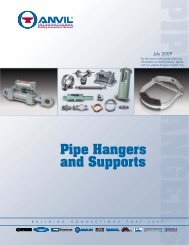Nibco Plastics Catalog - Paramount Supply
Nibco Plastics Catalog - Paramount Supply
Nibco Plastics Catalog - Paramount Supply
Create successful ePaper yourself
Turn your PDF publications into a flip-book with our unique Google optimized e-Paper software.
76<br />
AHEAD OF THE FLOW ®<br />
STORAGE<br />
Thermoplastic piping components are designed and manufactured<br />
for use in systems involving the transport of aggressive<br />
liquids as well as potable water. In order to ensure their<br />
integrity, they must be handled with reasonable care prior to<br />
installation.<br />
Pipe<br />
When pipe is received in standard lifts it should remain in<br />
the lift until ready for use. Lifts should not be stacked more<br />
than three high and should always be stacked wood-on-wood.<br />
Loose pipe should be stored on racks with a minimum support<br />
spacing of three feet. Pipe should be shaded but not covered<br />
directly when stored outside in high ambient temperatures.<br />
This will provide for free circulation of air and reduce the heat<br />
build-up due to direct sunlight exposure.<br />
Fittings<br />
Fittings should be stored in their original cartons to keep them<br />
free of dirt and reduce the possibility of damage. If possible,<br />
fittings should be stored indoors.<br />
Solvent Cements and Primers<br />
Solvent cements have a definitive shelf life and each can and<br />
carton is clearly marked with a date of manufacture. Stock<br />
should be rotated to insure that the oldest material is used<br />
first.<br />
HANDLING<br />
Pipe and Fittings<br />
Care should be exercised to avoid rough handling of thermoplastic<br />
pipe and fittings. They should not be dragged over<br />
sharp projections, dropped, or have objects dropped upon<br />
them. Pipe ends should be inspected for cracks resulting from<br />
such abuse. Transportation by truck or pipe trailer will require<br />
that the pipe be continuously supported and all sharp edges<br />
on the trailer bed that come in contact with the pipe must be<br />
padded.<br />
Solvent Cements and Primers<br />
Keep containers for solvent cements tightly closed except<br />
when in use. Avoid prolonged breathing of solvent vapors, and<br />
when pipe and fittings are being joined in partially enclosed<br />
areas use a ventilating device to attenuate vapor levels. Keep<br />
solvent cements, primers, and cleaners away from all sources<br />
of ignition, heat, sparks, and open flames. Avoid repeated<br />
NIBCO INC. WORLD HEADQUARTERS 1516 MIDDLEBURY ST. ELKHART, IN 46516-4740 USA PH: 1.800.234.0227<br />
TECH SERVICES PH: 1.888.446.4226 FAX: 1.888.336.4226 INTERNATIONAL OFFICE PH: +1.574.295.3327 FAX: +1.574.295.3455<br />
www.nibco.com<br />
www.nibco.com<br />
Revised 9/10/2009<br />
General Storage, Handling, and Safety Considerations for<br />
Thermoplastic Piping Components<br />
contact with the skin by wearing proper gloves impervious to<br />
the solvents. Application of the solvents or cements with rags<br />
and bare hands is not recommended; natural fiber brushes and<br />
other suitable applicators can produce satisfactory results.<br />
IMPORTANT FACTS TO KNOW ABOUT ABS, PVC, AND<br />
CPVC SOLVENT CEMENT<br />
1. ABS solvent cement should be used only for joining<br />
ABS pipe and fittings.<br />
2. PVC solvent cement should be used only for joining<br />
PVC Pipe and fittings.<br />
3. CPVC solvent cement should be used only for joining<br />
CPVC pipe and fittings.<br />
4. A good joint is as strong as the pipe, since the solvent<br />
chemically welds the fitting to the pipe.<br />
5. The solvent cement containers should always be covered<br />
when not in use to prevent excessive evaporation.<br />
Do not use thinner. Cement that shows signs of thickening<br />
and is lumpy should be discarded.<br />
6. PVC solvent cement and primer can be used for both<br />
PVC pressure and DWV piping systems.<br />
SAFETY CONSIDERATIONS<br />
Pipe and Fittings<br />
ABS, PVC, and CPVC products contained within this catalog<br />
are intended for use in the distribution of media that are<br />
chemically compatible with the piping materials. Due to the<br />
inherent hazards associated with testing these components<br />
and piping systems with compressed air or other<br />
compressed gases, NIBCO does not allow pneumatic<br />
testing or use of these products in compressed air or gas<br />
piping systems.<br />
Note: pressurized (compressed) air and other compressed<br />
gases contain large amounts of stored energy, which present<br />
serious safety hazards should the system fail for any reason.



